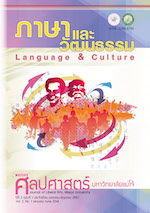เสกสรรค์ ประเสริฐกุลกับวาทกรรมความรุนแรงในวรรณกรรม (Violent Discourse in Seksan Prasertkul’s Literary Works)
Main Article Content
Abstract
งานวรรณกรรม หรือตัวบท ถือเป็นปฏิบัติการทางวาทกรรมรูปแบบหนึ่งที่ผู้ประพันธ์มีอำนาจในการสร้าง นำเสนอ หรือปิดกั้นอุดมการณ์บางอย่าง งานวิจัยนี้จึงได้เลือกใช้กรอบวาทกรรมวิเคราะห์เชิงทฤษฎีวิพากษ์ ของนอร์แมน แฟร์เคลาฟ์เพื่อที่จะชี้ให้เห็นว่าตัวบทดังกล่าวเป็นเพียงการประกอบขึ้นของสัญญะ (ไชยรัตน์ เจริญสินโอฬาร, 2545, น. 138) ที่ต้องการตอกย้ำและผลิตซ้ำอุดมการณ์ชุดหนึ่ง โดยใช้ภาษาเป็นเครื่องมือในการนำเสนอ เพื่อดำรงไว้ซึ่งอำนาจ หรือเพื่อสร้างความชอบธรรมในการขยายเครือข่ายของอำนาจ
ผลการศึกษาลักษณะวาทกรรมความรุนแรงและอุดมการณ์ความรุนแรงในงานวรรณกรรมของเสกสรรค์ ประเสริฐกุล จำนวน 10 เล่ม โดยอาศัยกรอบการวิเคราะห์ดังกล่าว พบว่า งานวรรณกรรมของเสกสรรค์ ประเสริฐกุล ได้สะท้อนภาพความทุกข์ยากของชนชั้นล่างจำนวนมากที่ถูกเอารัดเอาเปรียบ และถูกลดศักดิ์ศรีความเป็นมนุษย์
นอกจากนี้ยังพบว่ามีการสร้างวาทกรรมความรุนแรง 3 รูปแบบที่แฝงอยู่ในตัวบท ได้แก่ วาทกรรมอำนาจนิยม, วาทกรรมมาโซคิสม์ และวาทกรรมชายเป็นใหญ่ ซึ่งวาทกรรมทั้ง 3 ประเภทนี้ บอกได้เป็นนัยอย่างหนึ่งว่า เสกสรรค์ ประเสริฐกุล ยังไม่อาจ สลัดภาพของชนชั้นล่างที่มักจะถูกผู้มีอำนาจกระทำโดยใช้ความรุนแรงไม่ทางใดก็ทางหนึ่ง เปรียบเสมือนยอมรับการใช้ความรุนแรงดังกล่าวว่าเป็นเรื่องที่เกิดขึ้นโดยปกติ อีกทั้งยังสนับสนุนให้ชนชั้นล่างใช้ความรุนแรงในการตอบโต้ อันเป็นการตอกย้ำการสถาปนาอำนาจของชนชั้นนำให้แข็งแกร่งกว่าเดิม
The objective of this research was to study the characteristics of the violent discourse in the literary works of Seksan Prasertkul who was known as a contemporary writer and the pro-democracy student leader in the revolutionary uprising of October 14, 1973.
The literature works as a form of discourse practice in which the writer had the power to create, present or block certain ideology. This study therefore chose the Norman Fairclough’s Critical Discourse Analysis theory to point out that the context was created by using symbolic meaning to recreate series of ideology using language as the tool of presentation in order to maintain power or to create the righteouness in expansion of power.
The result of the study of his 10 literary works under the thesis framework found that the literary works of Seksan Prasertkul depicted suffering of the laborers who were the exploited people and reduction of human dignity.
In addition, it was found that the three discourses hidden in the literary works of Seksan Prasertkul were Authoritarian Discourse, Masochism Discourse and Patriarchy Discourse, which implied that Seksan Prasertkul still showed that the laborers were victims of violence. Furthermore, he encouraged the lower class to use violence in return, which could be seen as stronger power establishment of the elite group.

